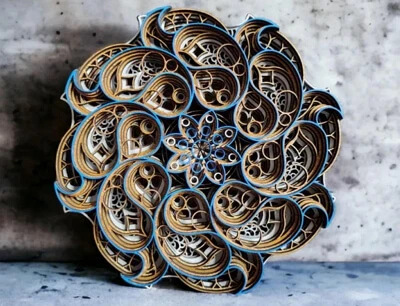
Introduction
Within the dynamic realm of art and design, laser-cutting technology is a particularly potent instrument that helps to close the gap between the imagined and the actual. This article explores the intriguing process by which the magic of laser cutting turns imaginative concepts into elaborate, real-world artworks.
The Science and Technology of Laser Cutting
What is Laser Cutting?
With the help of focused laser beams from a laser cutter, a variety of materials can be cut or engraved with precision and versatility. This process makes it possible to create intricate and detailed designs that would be challenging to do using more conventional techniques.
The Precision of Laser Technology
The unmatched precision of laser technology is one of its main benefits. Artists and designers love the laser engraver because of its amazing accuracy in cutting through materials, which allows for the flawless execution of even the most complex designs.
Materials Used in Laser-Cut Art
The unmatched precision of laser technology is one of its main benefits. Artists and designers love the laser engraver because of its amazing accuracy in cutting through materials, which allows for the flawless execution of even the most complex designs.
The Creative Process
From Concept to Design
A notion or idea is the starting point for the process of making laser-cut art. Artists frequently begin by using software to create digital models or by sketching out their ideas. The artist’s concept is then precisely executed by the laser cutter thanks to the conversion of these designs into vector files.
The Importance of Material Choice
The selection of materials is not merely a technical decision but a creative one. The material chosen for laser cutting impacts the design’s final look, texture, and even its structural integrity. For instance, wood offers warmth and natural beauty, while acrylic provides a modern, sleek finish.
Execution: The Cutting Process
Once the design and material are ready, the cutting process begins. The laser cutter, guided by the digital design, carefully carves out the intricate patterns or shapes, bringing the artwork to life. This stage requires careful attention to detail, as even a minor error can affect the final piece.
The Artistic Appeal of Laser-Cut Creations
Unique and Customizable Artworks
One of the most significant advantages of laser-cut art is its ability to produce unique, customizable pieces. Artists can easily modify designs to suit individual tastes or specific spaces, making each creation truly one-of-a-kind.
Versatility in Design
Laser-cutting technology is incredibly versatile, allowing for the creation of various artistic styles—from minimalist geometric patterns to elaborate, ornate designs. This versatility makes laser-cut art suitable for a wide range of applications, from home decor to fashion and beyond.
Enhancing Spaces with Laser-Cut Art
Laser-cut art has the power to transform spaces. Whether it’s a delicate wall hanging, an intricate light fixture, or a stunning piece of jewelry, these creations add a touch of sophistication and personalization to any environment.
Caring for Laser-Cut Art
Maintenance Tips
It takes careful maintenance to keep laser-cut art looking beautiful. Its beauty can be maintained with routine dusting and cleaning using the right supplies. Its lifespan can also be ensured by shielding the artwork from strong sunshine and excessive moisture.
Display Considerations
Lighting and positioning are crucial factors to take into account when showcasing laser-cut artwork. Sufficient illumination may accentuate the finer details, and well-planned positioning guarantees that the object is presented to its best advantage.
Conclusion
The technique of laser cutting is an amazing fusion of imagination and technology that turns basic concepts into magnificent, tangible works of art. This technology has the potential to completely transform the art and design industries, providing countless opportunities for both designers and artists as it develops.

